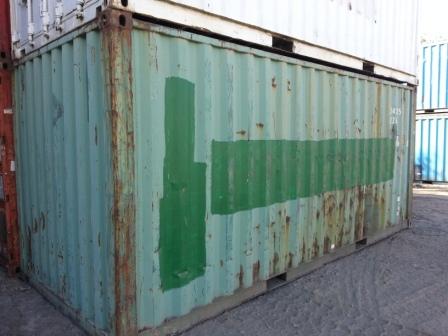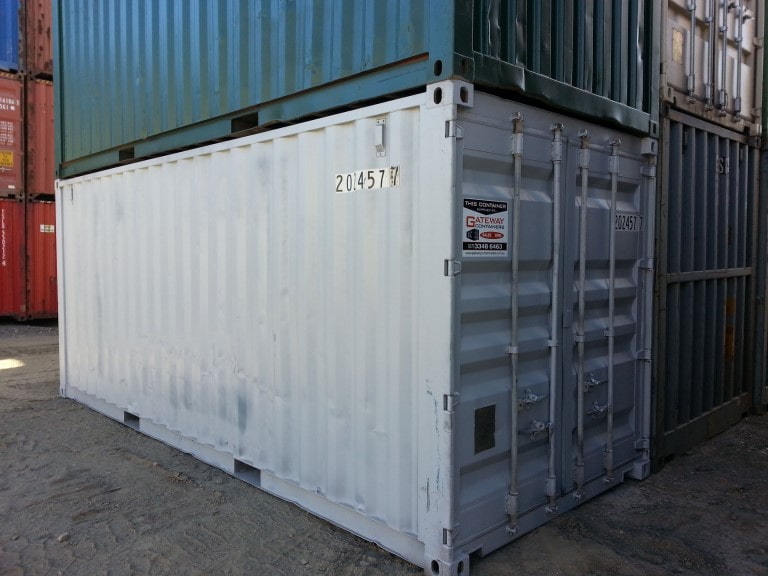New and used shipping containers are ideal solutions for temporary or long term storage, mobile offices, temporary buildings or even the basic building blocks for container homes. But with so many options, grades and shipping container modifications available, it’s incredibly easy to get confused and not know where to start.
Gateway Container Sales & Hire comes to the rescue, with this easy to follow guide that will give you step-by-step instructions on how to purchase (or hire) a shipping container. Ensure you get the right container for the right job, and excellent value for money at the same time.
10 Simple Steps to Purchasing the Perfect Shipping Container
1. Decide how you are going to use your container

Shipping containers have an incredibly wide variety of potential uses, from the obvious, to the obscure. Are you going to be using your shipping container as a stand alone storage solution, giving it basic modifications or using it as the base for a larger construction project such as affordable housing?
Your intended use will have a major impact on your budget, the grade of container you choose, the size and whether you purchase it outright or merely rent.
Common uses of second hand shipping containers coming out of the Gateway Container Sales & Hire workshops include (but are by no means limited to):
- General Storage (Our number one seller, simple, cheap, secure and effective)
- Ablution Units (Toilets, showers and washrooms)
- Accommodation Units
- Branded Containers (Perfect for portable signage)
- Container Shelters
- Document and Archive Storage
- Flammable Goods Storage
- Lunch Rooms
- Portable Offices
- Switch Rooms
- Training Containers
- Container Workshops
- And much much more!
2. Decide how long you require our shipping container for
Once you’ve worked out exactly what you’ll be using your shipping container for, you’ll also need to work out how long you need it. Is it for a permanent use (such as part of a building), temporary storage in the short term or a temporary building or office? Perhaps its long term document storage? The amount of time your require the container for along with its intended use will help you to decide whether you need to rent or purchase your container outright.
Generally speaking, if you wish to use your container for a short period of time, and require something that is off the shelf (such as a general storage container, or a slightly modified office container) then you might want to rent it.
If you wish to use the container for a long term, or it requires extensive modifications and customisation (such as doors, windows, electrical or plumbing fitouts, air conditioning, or huge changes to the structure) then you will be better off purchasing the container. You’ll often be able to sell the container for a decent resale value, that will be much cheaper than renting if you are likely to use it for a while and it’s kept in good condition.
3. Decide on the size of shipping container you require

What are you using your shipping container for? Different uses require different sizes. Do you need a tiny storage lockup? Then a 10 foot shipping container might be ideal. Or are you wanting a large accommodation unit? Then a 40 footer might be more the sort of thing you are looking for.
Shipping containers come in a wide variety of standardised sizes and configurations which are suitable for everything from construction and storage, to portable refrigerators including:
- 10 Foot (3m) Standard Dry Shipping Containers: These square shaped containers give you all the benefits of a shipping container, when space is tight and at a premium.
- 20 Foot (6.1) Standard Dry Shipping Containers: Probably the most common second hand shipping containers, 20 foot containers are the backbone of local and local trade and shipping.
- 40 Foot Standard Dry Shipping Containers: These large shipping containers are commonly used to ship product around the world and boast a massive 67.6 square metres of space. They are ideal when you have plenty of room to play with, and want to make the most of it.
Other less common containers include:
- 40 Foot High Cube Dry Containers
- 45 Foot High Cube Dry Containers
- 48 Foot High Cube Dry Containers
- 53 Foot High Cube Dry Containers
- 20 Foot Refrigerated Containers
- 40 Foot Refrigerated Containers
- 40 Foot High Cube Refrigerated Containers
Regardless of your space constraints, there is a perfect shipping container available.
4. Work out where to put your new or second hand shipping container
Once you’ve worked out the size of container you are going to need, you’ll also need to sort out the location for storing or installing your new (second hand) shipping container. Some local governments and councils have restrictions on portable storage, so make sure you check out local by laws and zoning requirements beforehand.
If you are purchasing or hiring a container for use in a residential neighbourhood, you’ll also want to run it past the neighbours, to ensure that you stay in their good books. You might need a permit, so make sure you get all the paperwork out of the way before your container is delivered to your site.
Make sure you have enough space to ensure delivery of your container. Generally this is around double the size of the shipping container plus around 10 feet. You’ll also want to level out the location that the container will be placed on, you can do this by laying blocks on the ground to ensure that it’s level in each corner and in the middle.
5. Gain an understanding of the various grades of shipping container

Shipping containers generally have quite a hard life, travelling the world at sea, standing up the the harsh ocean elements, as well as poor treatment by crane and fork hoist drivers. By the time they get to the yard they can be in a wide range of condition, from excellent to the downright poor.
It’s incredibly important that you get a good understanding of the different grading systems used to describe the condition of containers, especially if your are purchasing online and over the phone. Generally our containers from Gateway Container Sales and Hire are graded from A-C.
- A Grade Containers: Tend to between 8-12 years old and are in good condition. Surface rust has been buffed and primed, door seals are intact and the container is vermin proof, wind tight and watertight. These are ideal for storage of goods that are of value such as furniture, documents etc.
- B Grade Containers: Tend to be between 10-14 years of age and are of an average quality. There may be some minor surface rust, but door seals are intact making these containers wind and watertight. These are ideal for general storage that is required to be secure and dry, not necessarily as clean and tidy as with A Grade containers.
- C Grade Containers: These are your “budget” containers. Generally these will have a few dents, some surface rust, and the seals might not be wind and watertight. They are slightly older at 10-14 years old and used for general storage where you need security, but keeping the elements out isn’t absolutely essential.
Of course there are other terms that you’ll need to be aware of as well, these include:
- IICL5: The international inspection and leasing standard, which is very stringent and a sign of a quality container.
- CW (Cargo Worthy): This is exactly what it sounds like, a container that is fit for international shipping.
- AI (As Is): Again, just what it sounds like. As is, where is. There is no guarantee that these containers are fit for the purpose and have generally sustained damage, be it rust, dents or weathertightness. These containers are generally to be avoided unless it’s absolutely necessary to use one.
- Food Grade: Have a high standard of internal cleanliness.
- Furniture Quality: These containers are very clean inside and do not have any mess that will mark the goods stored or transported internally. Similar to A Grade.
- General Quality: You might see a few scuff marks and rust on these, but they are generally in reasonable condition. Similar to B Grade.
- Industrial Quality: These have a fair bit of rust, dents and markings. These are suitable for industrial storage where cleanliness isn’t important. Close to C Grade.
Other common terms are “one trip” containers which tend to be manufactured in Asia and are used for one shipment before being sold on the second hand market. These can be almost brand new and great value for money. If you plan to store your container outside, or anywhere near salty sea air you’ll want to ensure that your container is made of Corten Steel, which will stand up to the elements far longer.
Factory painted containers might be more harder wearing than refurbished containers, as the repairs and repainting might cover up rust of a poor job before hand. Always get a refurbished container checked over by someone who knows what they are looking at.
6. Search for a second hand shipping container for sale online
Next you’ll need to look online at various websites to get an idea of what is available and average pricing. Remember to get in touch directly with one of the Gateway Container Sales & Hire sales representatives early on in your search as well. These reps have a long history of experience in the industry, and know exactly where to look for the perfect container, be it an off the shelf second hand one, something brand new from the factory or a bespoke creation made to order.
7. Contact various shipping container companies for a quote

Shop around to ensure that your price is an accurate one for the shipping container you are purchasing. Remember that Gateway Container Sales and Hire is a major importer and distributor of shipping containers around Australia, and you’ll get a far better deal going direct to us – the source.
You can also search overseas auction sites such as ebay, but bear in mind that you will also have to factor in the cost of shipping, taxation and customs clearance as well as the potential risk of purchasing overseas, sight unseen. Our view is that its always better to purchase from a local supplier where you can see, touch and inspect the container before purchasing.
That said, it’s always important to get the peace of mind that you get when you are able to compare different quotes for the same or similar container. Compare container prices and you’ll be glad you came to Gateway Container Sales & Hire.
8. Arrange an inspection of your shipping container
You are almost ready to purchase your shipping container, and you are going to want to inspect it thoroughly. After all you wouldn’t purchase a car or a house online without a builders or mechanics inspection, and your shipping container purchase should be no different.
You may wish to carry out an in depth inspection yourself, or to hire a qualified third party. A qualified inspector can help you ensure that you have a sealable, secure container that is up to the requirements of long term use. It’s best to search online for an local inspector who can check the container out for you to see if it’s up to scratch.
If you are confident that you know what you are doing you may, however, choose to inspect the container yourself. Check that the doors close completely and are lockable. Avoid dented containers and check to see that the door seals are in good condition. Rust near the seals is likely to result in a leaky container, and bad odors are usually a sign of problems in the future, if the container doesn’t look, feel or smell right – move along to the next one. With the many hundreds of containers available at Gateway Container Sales & Hire, it is easy to find one that is suitable for your requirements.
9. Decide on Modifications and Container Customisation
If you are using the container for anything other than storage you are likely to require at least some basic modifications and customisation. Work with your container vendor to decide exactly what is required to be modified on the container and the exact scope of work. Get quotes for the modification along with the time frame and delivery date.
Make sure that the job is included in the contract at that there are clear deliverables and milestones. Once you have an idea of what is needed to be done, along with all costs involved you are ready to finalise the sale and purchase the container.
Common shipping container modifications and upgrades can include:
- A new coat of paint
- Lockboxes and alarms for added security
- Shelving for storage
- Side doors for ease of access
- Ventilation, insulation, HVAC or refrigeration
- Windows, doors or partitions
10. Purchase your new or second hand shipping container
Once you’ve gone through all these steps you are finally ready to hand over your hard earned cash and purchase your first shipping container. To start the ball rolling and enquire about your next container, give the team at Gateway Sales and Container Hire a call. They have years of experience and a wide range of modified and unmodified containers to meet whatever storage or building need you might have.




